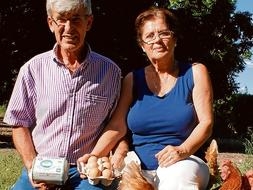
Pepe Urbano and Toñi Hevilla with their “happy hens”. :: Ángel de los Ríos
Noa runs barefoot through the vegetable plot, finds a fig and eats it with a clear delight that would surprise many town-dwelling parents. Noa is nearly three and figs are one of her favourite fruits.
“Children love growing up in the countryside. They learn to be patient, that they can eat these three strawberries which are red today, but if they want more they’ll have to wait until tomorrow,” says Noa’s mother, 37-year-old Cristina Lucas, who until three years ago used to live and work in Seville, as did her husband, who was an engineer for Renault. They both felt the call of the countryside, if not the wild, when Noa was conceived, and they have ended up in Coín, where their vegetable plot makes them self-sufficient, and they organise courses in ecological farming (www.cursoagriculturaecologica.com).
Cristina and Juan Luis don’t feel out of place in the Guadalhorce Valley. They are not the only young people to have moved from a city to the countryside, the opposite route to that which thousands of rural residents have been taking for decades.
They were seeking personal change, as the founders of Caña Dulce did 15 years ago: Caña Dulce, also in Coín, is devoted to permaculture, a philosophy of life which covers everything from sustainable agriculture to bioconstruction and yoga.
However, in the increasingly popular ‘eco’ lifestyle in this region of Malaga there are other profiles, too: people who want an alternative type of self-employment, those who decide to use a family plot as a source of extra income and farmers who have been converted to the idea of ecological production because it is more profitable.
The so-called ‘garden of Malaga’ is becoming green again thanks to the increase in ecological production, which has boosted the economy and the self-esteem of an activity which had lost its popularity.
Pepe Urbano is one of them. He and his family set up the first ecological chicken farm in the province on a two hectare site in Coín. As well as producing free range eggs from what Pepe calls his “happy hens”, the family grows pecan nuts. “Ecological produce has become fashionable, but it isn’t just a matter of the label. You have to believe in it,” insists Pepe.
Sebastián also stresses that this type of agriculture boosts other businesses. There are now more suppliers, fertiliser companies and industries which make bread, preserves, olive oil, cheese etc., in the ‘eco garden’ of Malaga province.
Joining a cooperative
One indication of the volume of business is the Guadalhorce Ecológico cooperative. It was formed by the association of the same name, brings together about 20 producers and provides work for five people in its premises in Alhaurín el Grande. The president of this cooperative, Miguel Angulo, says both production and consumption have grown in recent years and that this ‘eco revolution’ has had a dynamic effect on the area.
The recovery of traditional agriculture has also achieved something spectacular: consumers in Malaga have finally become enthusiastic about buying local produce.
“Our best products have always been sent elsewhere because people in Malaga were only interested in the price,” explains Sebastián.
In the beginning, ecological products from the Guadalhorce region were also exported abroad or, at least, were sent to northern Spain.
That has changed now, though, and much of the credit goes to the farmers’ markets organised by the Guadalhorce Ecológico association, which has been gradually raising awareness among consumers in Malaga.
These markets, which now regularly take place in six municipalities in the province, started in Coín nearly ten years ago. Between 15 and 22 producers from the region participate.
“The markets are very important because they bring consumers face to face with the producers and they then understand how this tomato or that cheese which they are going to eat is produced,” says Sebastián.
These markets have also led to something else which is new for Malaga: home deliveries of organic seasonal fruit and vegetables, either by individuals or through associations or consumer groups.
“This is something which is spreading through word of mouth. People are now organising regular deliveries to their places of work, for example,” explains Sebastián.
Worried about health
There are various reasons for the increasing popularity of organic products, including health concerns, an increasing interest in gastronomy and the work done by chefs from Malaga in stressing the quality of local produce.
Price is also a factor.“It is not true that ecological products are more expensive. We did a study in Malaga some time ago which showed that the fruit and vegetables our farmers sell are no more expensive than in the big stores,” insists Sebastián Hevilla.




